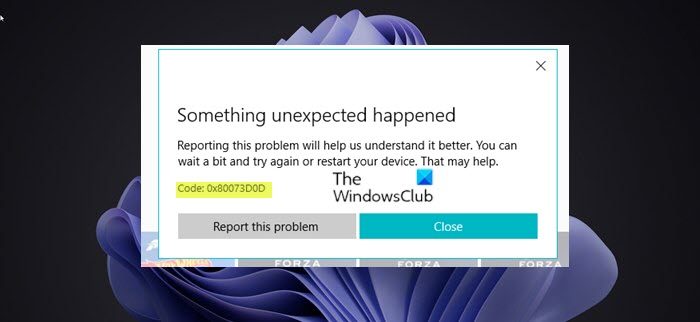Similar to Error code 0x80073cf4, you may also encounter this error code when you’re trying to move inbuilt system apps from one location to another.
Microsoft Store Error Code 0x80073D0D
If you have encountered the Microsoft Store Error Code 0x80073D0D when trying to download or install apps on Windows 11/10, you can try our recommended solutions below in no particular order and see if that helps to resolve the issue on your device. Let’s take a look at the description of the process involved concerning each of the listed solutions. Before you proceed with the solutions below, keep in mind that this error could be due to a transient issue at Microsoft end – so, as suggested on the error prompt, you can wait a while and then try again or restart your PC and make sure there are no connectivity issues.
1] Run Windows Store Apps Troubleshooter
You can begin troubleshooting to fix the Microsoft Store Error Code 0x80073D0D that occurred on your Windows 11/10 PC by running the Windows Store Apps Troubleshooter and see if that helps. To run Windows Store Apps Troubleshooter on your Windows 11 device, do the following:
Press Windows key + I to open Settings app.Navigate to System > Troubleshoot > Other troubleshooters.Under the Other section, find Windows Store Apps.Click Run button.Follow on-screen instructions and apply any recommended fixes.
To run the Windows Store Apps Troubleshooter on your Windows PC, do the following:
Press Windows key + I to open Settings app.Go to Update and Security.Click the Troubleshooter tab.Scroll down and click on Windows Store Apps.Click the Run the troubleshooter button.Follow on-screen instructions and apply any recommended fixes.
2] Repair or Reset Microsoft Store
You may Repair or Reset Microsoft Store via Settings.
2] Reinstall Windows Store using PowerShell
To reinstall Windows Store using PowerShell on your Windows 11/10 computer, do the following:
Press Windows key + X to open Power User Menu.Tap A on the keyboard to launch PowerShell (Windows Terminal) in admin/elevated mode.In the PowerShell console, type or copy and paste in the command below and hit Enter.
After the command executes, restart your computer and on boot, try opening Microsoft Store and see if the error reoccurs when you try to download/install a game/app. If so, try the next solution.
4] Repair Windows Store and update components
To repair Windows Store and update components on your Windows 11/10 device, do the following:
Launch PowerShell (Windows Terminal) in admin/elevated mode.In the PowerShell console, type or copy and paste in the commands below and hit Enter after each line.
Once done restart PC.
On boot, check if the issue in hand is resolved. Any of these solutions should work for you!
Why is my Microsoft Store saying error?
There could be a number of reasons why you’re encountering Microsoft Store errors on your Windows 11/10 device. The error code/message normally helps to narrow it down and as well determine the most appropriate solutions which generally includes checking for connection problems and making sure that you’re signed in with a Microsoft account and Windows is updated.
Why can’t I install from Microsoft Store?
If you’re having issues installing games or apps from Microsoft Store on your PC, you can try the following suggestions:
Try running the Windows Store apps Troubleshooter at Settings > Update & Security > Troubleshoot.Try resetting the Store cache.Go to Settings > Apps and highlight Microsoft Store, choose Advanced Settings, then Reset. After the app resets, restart the PC.
Is Microsoft App Store safe?
Yes. Apps are safe because they are approved by a team of developers and engineers at Microsoft. If you submit an app, the functioning, code, and other usability aspects will be verified by the team. Moreover, apps are also checked for the presence of harmful viruses.
Why does my Microsoft Store not download?
The most common and root cause of the app download failure you’re experiencing on the Microsoft Store on your Windows 11/10 PC is an outdated or bug-ridden Windows version/build. So make sure you install the latest update on your computer; go to Settings > Update & Security > Windows Update and click Check for Updates.

